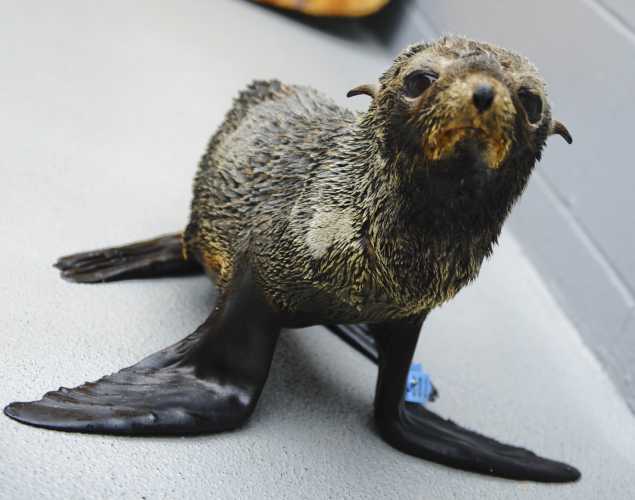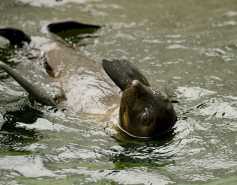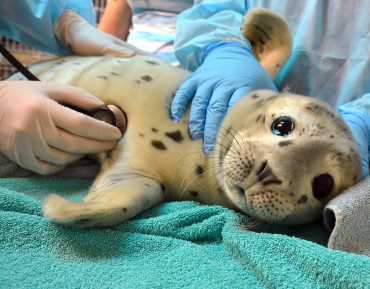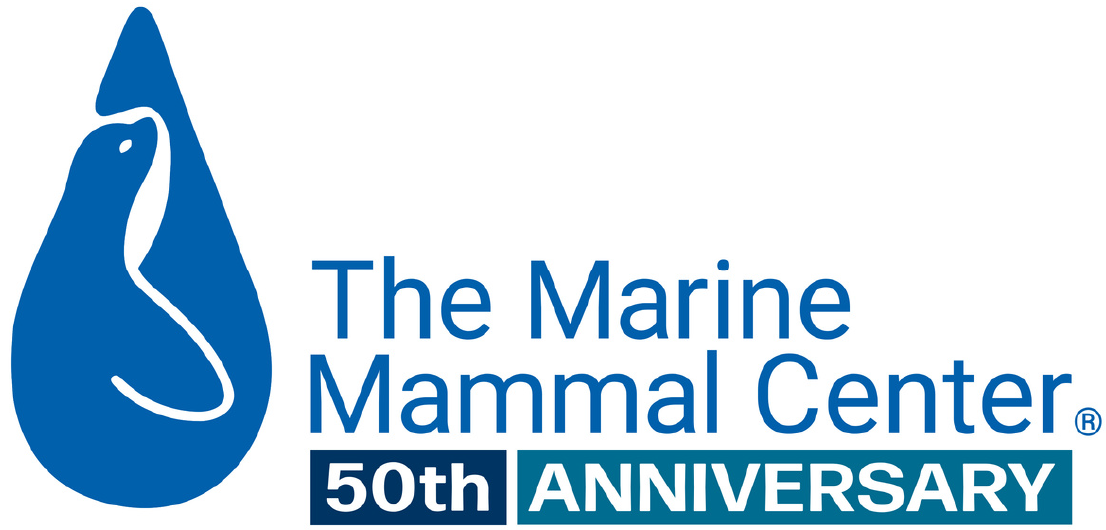
Guadalupe Fur Seals, a Threatened Species, Have Another Tough Year
- Telemetry
- Malnutrition
- Species conservation
- Climate change
After record strandings two years in a row, researchers are investigating this Unusual Mortality Event for Guadalupe fur seals along the California coast.
All told, The Marine Mammal Center rescued 32 Guadalupe fur seals in 2015 and we’ve responded to 32 more this year, including some animals found dead on the beach and brought to the Center for examination. To put those numbers into perspective, during our 40-year history prior to 2015, the record number of Guadalupe fur seals we had rescued in any given year was five.
These numbers are especially alarming because Guadalupe fur seals are listed as Threatened under the Endangered Species Act, with approximately 15,000 individuals remaining after being hunted to near extinction in the 1800s. Little is known about this elusive species, which spends most of its time offshore and rarely comes ashore along the coast of the United States.
What we do know about Guadalupe fur seals is that their primary breeding ground is Guadalupe Island, 150 miles off the coast of Baja California. Their life cycle is similar to their more abundant sea lion cousins, with mothers giving birth on the island in June and July, and temporarily leaving their pups on the beach as they forage for food nearby for nine months before pups are weaned in the spring.
Oceanographers say that unusually warm waters over the last few years affected food availability in the waters near Guadalupe Island and much of the North Pacific. As prey populations move away to cooler waters, mother fur seals have a harder time finding the food they need to nourish themselves and their pups.
The greatest threats to marine mammals are caused by people, but we can also be their greatest champions.
Sign up for email from The Marine Mammal Center to stay updated on how you can be an advocate and champion for threatened marine mammals like Guadalupe fur seals.
As a result of these changing environmental conditions, record numbers of Guadalupe fur seals like Chompers, a young female rescued in June from Salinas River State Beach, arrived at the Center in emaciated condition, with some as small at one year old as they would have been when first born.
The record number of strandings in 2015 led NOAA Fisheries to declare an Unusual Mortality Event, or UME, which is defined under the Marine Mammal Protection Act as a stranding event that is unexpected, that involves significant die-off of any marine mammal population, and demands immediate response.
Luckily for pups like Chompers, the animal care experts at the Center were able to get her the nutrition she needed to regain her strength and return her to the wild. She was released at a remote beach in Point Reyes National Seashore in October along with Wild Tangerine, another Guadalupe fur seal treated at the Center.
Unfortunately, not every stranded fur seal’s story has a happy ending, but the UME declaration allows for additional funding to research why these animals are stranding and how to help them.
Learn More About Guadalupe Fur Seals
{"image":"\/Animals\/Patients\/Guadalupe fur seals\/2018\/gfs-snaggle-by-dana-angus-c-the-marine-mammal-center-noaa-permit-18786.jpg","alt":"Guadalupe fur seal patient Snaggle","label":"Pinnipeds","title":"Guadalupe Fur Seal","link_url":"\/animal-care\/learn-about-marine-mammals\/pinnipeds\/guadalupe-fur-seal","type":"page"}

{"image":"\/Animals\/Patients\/Guadalupe fur seals\/2018\/cropped-images\/gfs-snaggle-by-cara-field-c-the-marine-mammal-center-noaa-permit-18786-376-0-3571-2789-1602455471.jpg","alt":"Guadalupe fur seal Snaggle","title":"Severe Entanglements Threaten Recovery of Guadalupe Fur Seals","link_url":"https:\/\/www.marinemammalcenter.org\/news\/severe-entanglements-threaten-recovery-of-guadalupe-fur-seals","label":"News Update","date":"2020-08-14 05:00:00","type":"news"}

{"image":"\/Animals\/Patients\/Guadalupe fur seals\/2020\/cropped-images\/gfs-pippin-by-bill-hunnewell-c-the-marine-mammal-center-noaa-permit-18786-111-120-3738-2920-1602702191.jpg","alt":"Guadalupe fur seal Pippin","title":"Understanding the Impacts of Climate Change on Threatened Guadalupe Fur Seals","link_url":"https:\/\/www.marinemammalcenter.org\/publications\/understanding-the-impacts-of-climate-change-on-threatened-guadalupe-fur-seals","label":"Research Paper","type":"publication"}

Understanding the Impacts of Climate Change on Threatened Guadalupe Fur Seals
Read More{"image":"\/Animals\/Patients\/Guadalupe fur seals\/2019\/cropped-images\/gfs-scooter-release-photo-c-steve-sayles-878-376-4402-3438-1606346089.jpg","alt":"Guadalupe fur seal","title":"Ecology and Conservation of Pinnipeds in Latin America: Guadalupe Fur Seal","link_url":"https:\/\/www.marinemammalcenter.org\/publications\/ecology-and-conservation-of-pinnipeds-in-latin-america-guadalupe-fur-seal","label":"Research Paper","type":"publication"}

Thanks to funding from the National Marine Sanctuary Foundation, the SeaWorld Stranding Support Fund and others, we have been able to attach satellite tags to all 25 of the Guadalupe fur seals we’ve released over the last two years.
When the animal surfaces, these tags ping location data via satellite to researchers like Tenaya Norris, a marine scientist at the Center, providing valuable information about where these animals live when they’re not at Guadalupe Island.
Norris, who also serves as an Onsite Coordinator for the Guadalupe fur seal UME Investigative Team, says the tag data she’s received so far has revealed some unexpected findings. For example, all 10 of the pups released in 2015 swam north into waters between Oregon and British Columbia, Canada.
“We were surprised to see animals this young traveling so far north, and some of these animals were traveling huge distances quickly,” Norris says. “The more data we have, the more effective we can be in protecting this threatened species.”
During a UME, any Guadalupe fur seal that doesn’t survive is given a full necropsy, or animal autopsy, by a veterinary pathologist such as Dr. Padraig Duignan, The Marine Mammal Center’s chief pathologist, to determine why it died and gather life history data such as nutritional state, diet, age and reproductive history.
Tissue samples are also taken and sent off to be specially prepared on a microscope slide, which can then be read and interpreted by a pathologist to gain even more insights into the animal’s health.
But studying animals that have stranded for one reason or another only offers a small glimpse into the health of the entire population. To learn more about “normal” Guadalupe fur seal behavior in the wild, researchers must monitor healthy animals—and one of the best places to find them is Guadalupe Island, where adult fur seals gather to breed each year.
Earlier this year, Norris joined Mexican researchers on a trip to the remote Guadalupe Island rookery to learn more about healthy fur seals and track their behavior in the wild. She’ll return in 2017 along with other biologists and veterinary experts from the Center to continue her research.
“The Guadalupe fur seal UME has benefited the scientific community by fostering cross-border research collaborations with our colleagues in Mexico,” Norris says.
Since these animals don’t recognize international borders, it’s vital that we all work together to better understand this threatened population and how to protect them.
You Can Be a Marine Mammal Hero
You can help provide the critical care needed to return stranded Guadalupe fur seals to their ocean home. Your contribution goes a long way to help individual patients like Chompers as well as support scientific research that will help ensure a healthy ocean future for marine mammals and humans alike.
Header photo by Dana Angus © The Marine Mammal Center / NOAA permit #18786
Yes, I want to save a life!

Yes, I want to save a life!
You’ll be giving sick and injured animals the best possible care at the Center’s state-of-the-art hospital. With your gift today, you are giving a patient a second chance at life in the wild.
See Our Latest News
{"image":"\/Animals\/Patients\/Harbor seals\/2020\/cropped-images\/hs-barnwood-by-bill-hunnewell-c-the-marine-mammal-center-315-0-3299-2577-1607370547.jpg","alt":"harbor seal Barnwood","title":"Last-Minute Gift Guide \u2013 Top Gifts that Give Back to Marine Animals","link_url":"https:\/\/www.marinemammalcenter.org\/news\/last-minute-gift-guide","label":"News Update","date":"2025-12-18 01:00:00"}

Last-Minute Gift Guide – Top Gifts that Give Back to Marine Animals
December 18, 2025
Read More{"image":"\/Animals\/Patients\/Hawaiian monk seals\/2025\/cropped-images\/b-ru72admission-to-ke-kai-ola112125photo-c-the-marine-mammal-center-noaa-permit-24359-0-364-1270-992-1766095407.jpg","alt":"A newborn Hawaiian monk seal pup with a black coat in rehabilitative care.","title":"Newborn Hawaiian Monk Seal Pup Now Receiving Care","link_url":"https:\/\/www.marinemammalcenter.org\/news\/newborn-hawaiian-monk-seal-pup-now-receiving-care","label":"Patient Update","date":"2025-12-18 01:00:00"}

{"image":"\/Animals\/Patients\/Hawaiian monk seals\/2025\/cropped-images\/d-ru28release-exam-at-ke-kai-ola111025photo-by-giancarlo-rulli-c-the-marine-mammal-center-noaa-permit-24359-0-0-1270-992-1764620886.jpg","alt":"","title":"Bird Flu Vaccine Trial Offers Hope for Protecting Hawaiian Monk Seals","link_url":"https:\/\/www.marinemammalcenter.org\/news\/bird-flu-vaccine-trial-may-offer-hope-for-protecting-hawaiian-monk-seals","label":"News Update","date":"2025-12-01 08:13:00"}

Bird Flu Vaccine Trial Offers Hope for Protecting Hawaiian Monk Seals
December 1, 2025
Read More{"image":"\/Animals\/Patients\/Hawaiian monk seals\/2021\/hms-pp08-by-sheila-latta-c-the-marine-mammal-center-noaa-permit-18786.jpg","alt":"Hawaiian monk seal","title":"The New York Times: Inside the Bird-Flu Vaccine Trial for Monk Seals","link_url":"https:\/\/www.marinemammalcenter.org\/news\/the-new-york-times-inside-the-bird-flu-vaccine-trial-for-monk-seals","label":"In the News","date":"2025-12-01 01:00:00"}

The New York Times: Inside the Bird-Flu Vaccine Trial for Monk Seals
December 1, 2025
Read More

